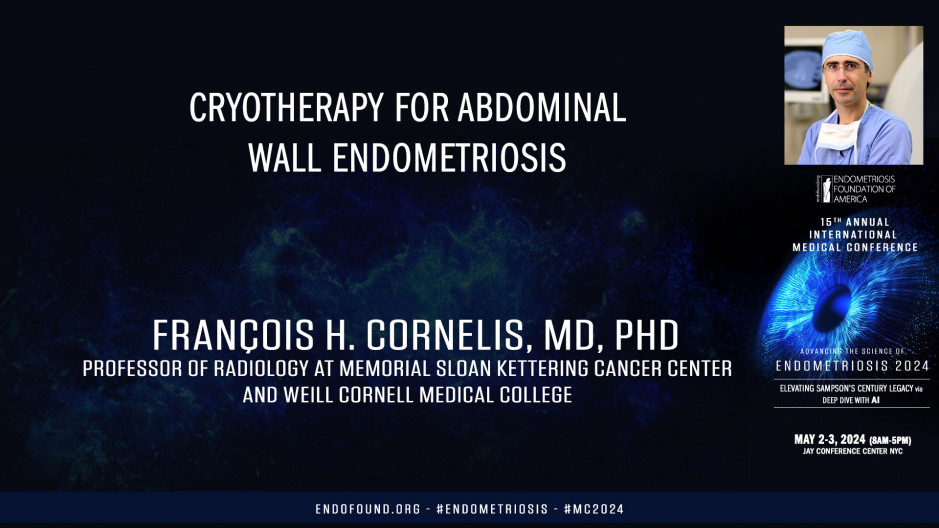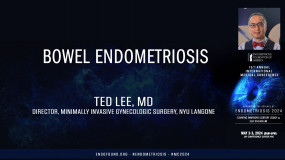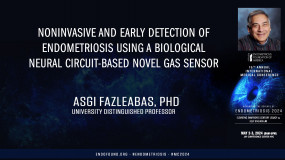International Medical Conference
Endometriosis 2024:
Elevating Sampson’s Century Legacy via
Deep Dive with AI
For the benefit of Endometriosis Foundation of America (EndoFound)
May 2-3, 2024 - JAY CENTER (Paris Room) - NYC
All right. Good afternoon. I have to apologize. I'm not a surgeon, I'm anal radiologist so I'm just doing procedure using imaging guidance and I would like to thank you for the invitation. It's not so often we are invited in these kind of conferences. So I would like to thank you. I'm going to present you a work. I started almost 10 years ago on Cryoablation of Abdomen Rule and the osis. And as you can hear, and you can see this work start in France. So as I mentioned 10 years ago in Bordeaux in the southwest of France. Then after I developed this, the in Paris before moving to M-S-K-C-C and Cornell three years ago.
So these my disclosure, it's not working. Yeah, we'll go. I would like to start with just a basic case. So just go back to what we are all doing. It's medicine. So I would like to present you this first case of cryoablation. I would say maybe at least in France or maybe in the world. It was in December, 2011. This 34 year woman came and came to see my colleague from gynecology surgeon. She came because she had a baby of six months ago and she had a C-section and she had very severe abdominal pain. Nine to 10 we can feel a no increasing volume. But the issue for her, above her and beyond the pain, she was a professional toilet. So she cannot train, she cannot make a living and that was a serious issue for her. So all the imaging was perform and on ultrasound and MRI, they discovered 20 millimeters mass heterogeneous and the radiologist at that time mentioned it may be a moid tumor.
Obviously I'm not going to explain what it was, but it was an abdominal wall endometriosis because of all history and the location and the aspect of imagery. So the surgeon, and I'm sorry maybe it's not accurate, offer the patient to perform a surgery but this lady was Toyota and she didn't want to have any interruption in her practice and she want to go back to her training as soon as possible. So the surgeon came to me and we were discussing this in DMT about any percutaneous option, can you do something? And the reason why he came to me is because I was at that time doing some cryoablation for soft tissue tumors located almost everywhere and sometimes in abdominal wall and mainly on desmoid tumors. So I started in 2010 and also I was doing some low flow vascular malformation same year. And you can see in this case first case published was on the breast and we had some good results.
So I told him, Hey, why not trying what we are currently doing that this cryoablation of soft tissue tissue tumor and let's see how it works. But why using cryoablation? Because cryoablation is you are introducing a very small tenile between 17 gauge to 13 gauge, which mean 1.5 millimeters to 2.4 millimeters diameter and at the tip of the needle using argon gas circulating inside the needle without delivering anything in the tissue or using nitrogen liquid nitrogen, we are delivering very cold temperature and this very cold temperature are producing some cell death when the temperature reaching minus 40 degrees sections below this, the cells are killed. Or if we are doing cycle we can have some OS asthmatic effect, we can have some apoptosis, some immune response or vascular effect because of the ischemia and it start between zero to minus 20. The good thing is all this effect are helping us to kill the cells.
So to deliver this we have still tank, we have some mashing. You can see here it's quite small and we are using imaging guidance to place the needle. You see on the lower left we have tank bringing the organ gas we are using in the needle and we can adjust the length of the needle when the patient, I mean in the mass of the patient. And that's more or less a technique we are using in the abdomen wall. So you have the mass you see in yellow on the upper left then we are sticking a needle as I mentioned, between one to two millimeters diameter. We are starting to produce the ice ball that we can see with imaging. We can see it with ultrasound, we can see it with CAT scan or MRI. So we have very good monitoring of what we are doing and this is very important to stick the needle under imaging guidance to start the process of cryoablation and then to cover all the mass with the ice ball to allow us to treat the patient but in meantime to not having complication.
And the complication could be on the skin or it could be in that close to the BO in case of the abdomen Bo. And all of these make this procedure very straightforward and this is a case, this is another case, this is not my lady I mentioned in the beginning but this was a location of endometriosis of the umbilicals where we treated with three cryo pop. You can see on the lower access to the bolus. Before starting we were doing all what you can see on the right side which is so in the globes there is some warm saline trying to avoid complication of the skin. We also inject some local anesthesia. So lidocaine between the mass and the skin, firstly to have some energetic effect but also to protect the skin by increasing the distance between the mass and potentially the ice bowl and the skin and in depth in the abdomen.
We are doing exactly what you are doing. We are delivering CO2 to do a carbo dissection and to have the bowl removed from the area. And this is what we get when we are doing this kind of pressure. On the left side you have the ice bowl. So this is all the black mark you see with the star. It's on the ultrasound guidance so we can clearly see what we are doing. What we are trying to is to start the ice bowl within the center of the mass and when the ice bowl extend outside the boundaries of the mass, then we stop. And on the right side you see what we obtain with CAT scan where you can see the ice board with two young and the two needles on the AB of the abdominal wall. And below this you see all the CO2 trying to avoid to have the ball going close to the ice board that may produce issues.
So that's the technique we used in this patient. It's after we developed. So what are the evidence in 2024 now? So more than 10 years after we started. So the first report I published was in 2014 from Bodo. So Bodo is the southwest of France and we published these two papers in 2014 2017 where we can see what we did exactly what I described previously on the MRI. You see the nodule on the left side on the upper in the mineral, it's on the ultrasound, the ice bowl in the lower middle. And after six months, this one was after one year you see everything is gone. So without doing surgery scar, the patient had this mass result. So the evidence, it's also compared to currently the publication on our management of Abosi in blue is the surgery in light blue and in the dark blue is the correlation starting in 2014.
And you see even if the surgery increased, which is probably because we are treating more and more patients because we are able to see to detect these masses. Cryoablation increased with several publication. And this is a summary of the publication. I'm not going to describe them but I'm going to describe you two papers we published. So the first one was published, it's from Paris from ban. It's over six years study including clinical trial. We conduct what we demonstrate in this series of 42 patients. We had a very nice pain relief after you can see on the left side the pain range between seven to 10 and after the procedure was almost zero and it was quite sustained results because over 12 months we have like 80% good results after the cryoablation with only very few adverse events. Most importantly in this patients we perform a score where we were evaluating the quality of life and how everything was going after.
And we have a very low score I mentioned I don't mentioned but this study was performed with the team of geneal of orbital tunnel and maybe there is a famous gynecologist emit in this place. So we have this very promising result. And recently, so one month ago we published this 10 year follow up. It's a long study from Bodo, more or less the same number of patients and the same results in term of pain control with almost 80%. And this study was performed with geneal team. So you may familiar with Jean Brown and O was woman. We were doing this and we obtain the same results that the previous study I performed in Paris in term of adverse events we have some issue on the skin but very low. We had only three cases where the ice went to the skin. The reason was because the needle was not insulated at that time.
So we had this issue for a couple of patients, we had some paresthesia but it's maybe also ready to the c-section. And we were not able to address this. We had one case of bowel inflammation after the reason is because the CO2 was removed before the ice board. So the bowel went close to the ice bowl and produced this inflammation but the patient didn't have a surgery after another case. And very unfortunate that's it's a case I did refer by oral to treat this sno. It's not abnormal. Wall end release is quite deep and it was just for him to not be able to do the surgery. So you refer this patient to me to do this posture but unfortunately the nerve, the cutaneous nerve was very close and the patient developed paresthesia. The good thing with the cryo is after one year the patient recover. I mean your patient has to wait one year to recover but this something the patient are recovering but very tricky and challenging location. So what's next two different project? One is in bo. So they are doing a combined approach with surgical and cryoablation for AOVs. And another one I'm developing at m Ms KCC is moving to malignant tumors after surgery treatment where there is recurrences and without any other options.
And so that's my final slide. And in conclusion, so cryo elevation is something working. I don't say it is going to change the practice but it may help you to focus on the deep endometriosis and maybe there is room for this treatment and I would be happy to collaborate with all of you. We need this centric prospective clinical trials. We need to develop this in the US Currently it's really well ongoing project in France and Europe, but in the US it's almost zero. So we need also your help to develop this with collaboration. It's not higher work, it's a team fault and we have to work altogether to address these issues to the patient. And there is also some need for research to have a better understanding of what's going on. And so that's been also we need fundings. Thank you for your attention.










